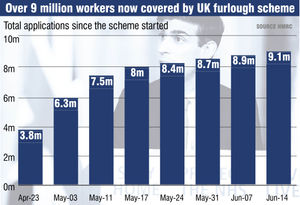Timebomb ticking on unemployment as end of furloughing approaches
A timebomb is ticking on unemployment in the West Midlands as the end of the coronavirus furlough scheme in October draws ever nearer.
The latest Office for National Statistics figures for the three months to April actually showed a fall of 8,000 in the regional unemployment figure to 141,000 ,with the unemployment rate at 4.8 per cent of the working population.
But across the region the number of people temporarily away from work, including those furloughed, has soared
The removal of furloughing is expected to lead to a surge in unemployment as many may not have a job to go back to.
Across the Black Country there were nearly 10,000 extra claims for unemployment benefits, including Universal Credit, made last month.
Numbers claiming were up 3,320 in Sandwell to 18,535 – 9.1 per cent of the working population, 1,830 in Dudley to 14,705 (7.6 per cent), 2,150 in Wolverhampton to 16,865 (10.3 per cent), and 2,910 in Walsall to 15,170 (8.8 per cent).
Staffordshire’s total was up 6,385 to 27,260 (5.1 per cent) with Cannock Chase having a rise of 955 to 3,980 (6.3 per cent), South Staffordshire up 605 to 3,150 (4.7 per cent), Stafford up 835 to 3,670 (4.4 per cent), and Lichfield rising by 795 to 3,085 (five per cent).
Wyre Forest, including Kidderminster, had a rise of 695 to 3,685 (6.3 per cent).
Figures for the West Midlands show the numbers claiming were up 47,305 to 265,030 (7.3 per cent).
Cathy Taylor, a business development manager and spokeswoman for Jobcentre Plus in the Black Country, said she was just starting to see people being made redundant in the region, although the furlough scheme would be continuing for some months and some furloughed people were returning to work.

She said Midland Engine work coaches were matching unemployed people to jobs that were available and the organisation was working closely with local authorities to support people out of work with transferable skills towards employment and direct people to online training opportunities.
“The care sector is one area where jobs are available and some employers are looking for people to start work now,” she added. Figures for unemployment in his Warley constituency were described as “truly shocking” by the MP John Spellar. Up to the end of May, 11,800 jobs had been furloughed through the Government’s Job Retention Scheme in the constituency and 2,800 claims were made to the Self Employment Income Support scheme.
There were 5,910 claimants in Warley in May 2020, which was 9.5 per cent of the working population.
“An unemployment figure of nearly 10 per cent is a truly devastating figure, especially as more redundancies are rolling through on a daily basis. Unemployment is devastating to individuals, families and communities. This is a national crisis and the Government must up their game to get Britain back to work,” he said.
The Lichfield constituency had 12,500 furloughed and 3,200 claims were made to SEIS.
Lichfield MP Michael Fabricant said: “Sadly, I fear that we will only see a return to the normal rates of high employment in our area when the pandemic has ended probably as a result of mass vaccination which will be many months yet.”
He said the claimant figures included those who had their claim processed by the Department for Work and Pensions by the middle of May, almost two months after the Government’s instruction to stay at home.
“This shows that both employed and self-employed workers in the Lichfield constituency – which includes Burntwood and reaches north of Abbots Bromley – are taking full advantage of the Government’s support schemes. This is helpful in keeping the economy going during this unprecedented pandemic.
“Those who are not on Covid-19 support schemes in the Lichfield constituency and are unemployed and claiming benefits represent 4.9 per cent of the working population locally which compares extremely well with the national average of 6.4 per cent,” added Mr Fabricant.
Midlands unemployment to double over summer
An economist is warning that unemployment across the Midlands could double over the summer
The head of research at the Midlands Economic Forum, Paul Forrest, said the latest unemployment figures for the three months to April – a rate of 4.3 per cent of the working population in the region – do not fully reflect the impact of the coronavirus at a regional level.
He said that the claimant count has accelerated from 144,350 in March in the West Midlands to 265,030 by May.
Mr Forrest said that overall in the Midlands, the latest data records the total number of furloughed staff as 1.26 million, equivalent to 23 per cent of the economically active.
"Assuming a doubling of the unemployment rate, those unemployed and furloughed leave an overhang equivalent to over a third of the economically active.
"For instance, in the metropolitan West Midlands – the West Midlands Combined Authority area – this is equivalent to 37 per cent of the economically active.
"In addition, with between a fifth and a quarter of the labour force currently furloughed, close to 37 percent of the active labour, in Birmingham for instance, is not directly producing output."l, unemployment rose 0.1% to 3.9%, and the employment rate increased by 0.3% to 76.4%.
Full impact ‘to be felt at end of year’
Economists believe the full impact on employment will not be felt until wage support schemes end in October. They say businesses are now having to assess how they must change to survive long-term.
Fiona Cincotta at Gain Capital said: “Whilst the Government’s furlough scheme offers an unprecedented amount of support to the UK labour market, we can expect to see this start to unravel in the coming months as the scheme is gradually withdrawn.”
Tej Parikh, of the Institute of Directors, added: “The furlough scheme continues to hold off the bulk of job losses, but unemployment is likely to surge in the months ahead. Wage support has given firms some much-needed time to regroup.”
Matthew Percival, CBI director of people and skills, said: “We can now clearly see the significant impact the virus is having on the labour market already. Over 600,000 people were taken off payroll between March and May, vacancies fell by the largest amount on record on the quarter, and hours worked fell at the fastest pace on record over the year.
“Unemployment falls unevenly across society and leaves scars that last generations. The urgent priority must be creating inclusive jobs today, by turbo charging the sustainable industries of tomorrow. This should be backed by a revolution in retraining, with business, government and education providers stepping up to reskill communities for the future.”





